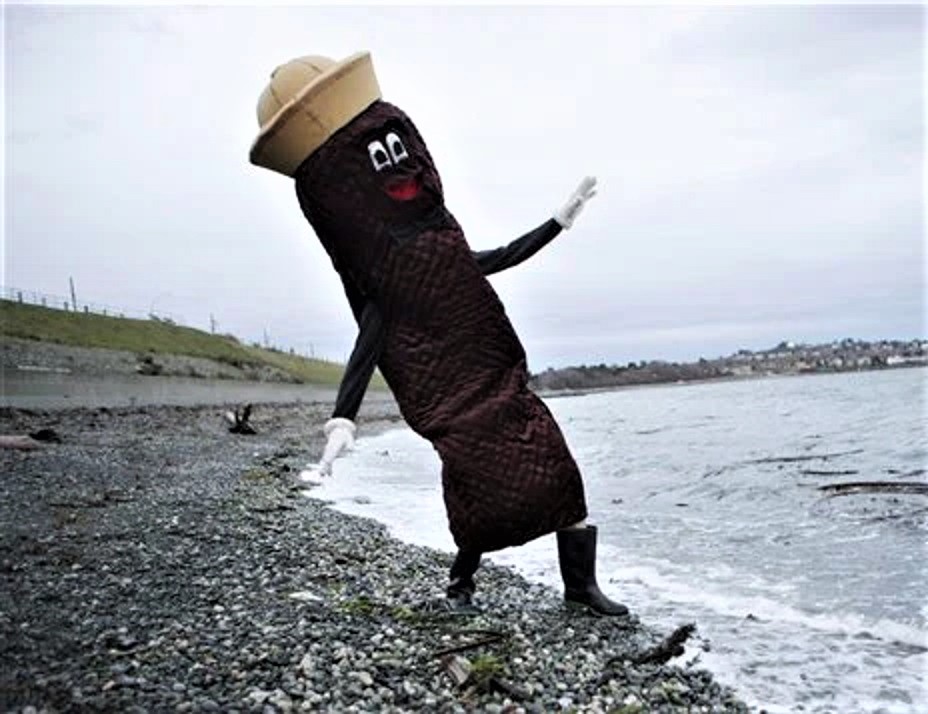
Sewage treatment in Victoria | McLoughlin Point Wastewater Treatment Plant
#5501

Posted 28 November 2021 - 01:41 PM
- Nparker and todd like this
#5502

Posted 28 November 2021 - 01:55 PM
...Might also be for the new McLoughlin sewage plant, both the emergency flow pipe (which was the only sewage pipe) and the treatment stages may have been downgraded with the exceptionally-high flows down to just screening...
That was $1 billion dollars well spent.
#5503

Posted 28 November 2021 - 03:19 PM
John do you happen to know if the turd plant has resumed shipping solids to the mainland or are they still hiding it in the forest?
No, I don't know - haven't been following the sewage sludge disposal issue very much.
Latest news item I found suggests that as of June, the residuals would be dumped at Hartland but expectation that it would be back on track in the future: https://vancouverisl...-says-1.5473839
I tried to follow the webcast stream of what the CRD sewage committee is saying in their meetings and all I can glean from their 46-minute October meeting is that they are expecting stability of the system some time in 2022: https://www.crd.bc.c...ement-committee
Something interesting is the discussion at 28-minute mark in the webcast and seems that Inflow and Infiltration ("I and I") is a hot-topic. I and I into sewage pipes has been a big deal because costs more to treat higher volume from rainfall leaking into the sewage system and not going to storm drain system like it should.
Last few minutes of webcast has some mention of unfunded liabilities that will have to be negotiated with municipalities and First Nations and extra capital needed for controlling odor at the plant (not sure if its McLoughlin plant or Hartland plant).
#5504

Posted 28 November 2021 - 04:08 PM
- todd likes this
#5505

Posted 03 December 2021 - 04:20 AM
https://www.vicnews....ction-repairs/#
That’s an interesting article. I didn’t know the rainy day flow rate was over 4x the dry day rate.
Wouldn’t finding the cross-connections be the preferred first step?
I’m concerned that replacing a lateral at $15,000 taxpayer cost to prevent a small amount of infiltration is not cost efficient. Especially when that lateral completely fails, the cost is bourne 100% by the property owner.
What is the actual cost to treat at the plant one litre of storm water? So how much is it costing us to treat storm water each year?
Edited by Victoria Watcher, 03 December 2021 - 04:27 AM.
#5506

Posted 03 December 2021 - 08:57 AM
The CRD’s core area liquid waste management plan also commits Victoria and other participating municipalities to reduce their maximum daily wet-weather flow to less than four times the dry weather average by 2031 – a requirement that implies improvements to inflow and infiltration.
https://www.vicnews....ction-repairs/#
That’s an interesting article. I didn’t know the rainy day flow rate was over 4x the dry day rate.
Wouldn’t finding the cross-connections be the preferred first step?
I’m concerned that replacing a lateral at $15,000 taxpayer cost to prevent a small amount of infiltration is not cost efficient. Especially when that lateral completely fails, the cost is bourne 100% by the property owner.
What is the actual cost to treat at the plant one litre of storm water? So how much is it costing us to treat storm water each year?
Bottom line is that the CoV and others spent their reserves funding their operational dreams and now they want to cover the infrastructure deficit they created by having homeowners pay for it. Of course it won't affect affordability however!
- Nparker likes this
#5507

Posted 03 December 2021 - 09:00 AM
Know it all.
Citified.ca is Victoria's most comprehensive research resource for new-build homes and commercial spaces.
#5508

Posted 03 December 2021 - 09:03 AM
But there has been nearly endless money to fund bike lanes, used by maybe 5% of the population.
#5509

Posted 03 December 2021 - 09:05 AM
Know it all.
Citified.ca is Victoria's most comprehensive research resource for new-build homes and commercial spaces.
#5510

Posted 03 December 2021 - 09:05 AM
Bottom line is that the CoV and others spent their reserves funding their operational dreams and now they want to cover the infrastructure deficit they created by having homeowners pay for it. Of course it won't affect affordability however!
Well, the way I see it, the pipes do belong to the homeowner. But now it sounds like they at the very least want to make homeowners inspect their own pipes at the homeowners cost, even if there is no problem detected.
Making property sales conditional on having lateral pipes inspected – and upgraded if necessary – was one potential solution offered, Jas told council. Requiring plumbing or building permits valued at $25,000 or more to include lateral pipe inspection was also suggested in the report.
Edited by Victoria Watcher, 03 December 2021 - 09:07 AM.
#5511

Posted 17 December 2021 - 05:16 PM
Less than 7 per cent of waste destined for cement plant made it there through October
https://www.vicnews....so-far-in-2021/
- Nparker and phx like this
#5512

Posted 17 December 2021 - 05:23 PM
That was $1billion well spent.
- Matt R. and A Girl is No one like this
#5513

Posted 17 December 2021 - 06:51 PM
“…When operating as designed, the residuals facility should turn the largely de-watered sludge from the McLoughlin Point wastewater treatment plant into small, dried pellets to be burned as fuel at the Lafarge cement plant in Richmond…”That was $1billion well spent.
funny because the project does smell like
Edited by todd, 17 December 2021 - 07:21 PM.
#5514

Posted 17 December 2021 - 08:23 PM
That was $1billion well spent.
There are probably close to 70K-80K sewage treatment plants in the world. The Victoria plant is not amoungst the largest or the most complex. We should not be having this many problems.
I wonder if this is the real reason Ms. Bird quite as chair after a year.
- Nparker likes this
#5515

Posted 17 December 2021 - 08:25 PM
- todd likes this
#5517

Posted 18 December 2021 - 09:42 AM
This is the last time I trust a giant dancing ****.
Filthy piece of https://youtu.be/0-waLIQnTYY in the PM’s words.
Edited by todd, 18 December 2021 - 09:53 AM.
#5518

Posted 18 December 2021 - 02:49 PM
Warning this is a bit of a lengthy read but if you are interested in how the CRD has been serving our communities with regards to sewage treatment and our environment, this should get your thinking cap spinning.
Let's start with a CTV News report form June of this year just to bring you up to speed.
From here I am going to attempt to break down some of the doublespeak that we are being handed from the "official responses" included the article penned by Jane Skrypenk of Victoria News from yesterday.
Victoria News December 17 2021
"... as of the end of October, less than seven per cent of the region’s treated sewage for the year has made it to Lafarge. More than 6,000 tonnes of the de-watered sludge, either as less-processed “controlled waste" or provincial Class A biosolids, have been deposited at the Hartland landfill instead."
The interesting point of the above statement that would appear to compare the amount of treated sewage that made it to the Lafarge cement plant this year, but the interesting part of this statement is that it also differentiates that there are now two classes of waste. Less-processed "controlled waste" and Class A Biosolids. The public, as far as I know, have been led to believe that this sewage treatment plant would produce only Class A Biosolids. I have no idea as to what contaminates, pathogens, metals, pharmacudicals or other "nasties" might be contained in less-processed "controlled waste". Do you?
"Reports for the first three months of the year aren’t public, but CRD senior manager of environmental protection Glenn Harris confirmed all residual waste was landfilled during that time. [...] From late April to early July, the facility’s only active digester – responsible for breaking up the residual solids or sludge – stopped working properly. Only 19 of the 3,999 tonnes produced during those months made it to the cement plant."
Watch out for the tricky math break down above. It would appear that during the first three months of this year all of the solid waste was placed in the landfill. Then some 19 tonnes was sent to Lafarge during the next three months. Keep in mind that the headline of this article states that less that 7% of the waste has been sent to Lafarge so far this year but the math above only refers to .475%. More math below.
In addition, Harris said, unexpected plant closures by Lafarge and some cancelled ferry trips have led to lost deliveries.
Here is some distraction that blames some of the shortfall of shipments were due to ferry cancellations. Really?
"In a fully functional year, the CRD expects to turn all residual waste into Class A biosolids, rather than the 19 per cent converted so far this year. Only 700 tonnes of those biosolids should remain at the landfill while Lafarge performs annual maintenance. Plans call for those 700 tonnes to be used as biocover to reduce landfill gas emissions, and as a sort of fertilizer to encourage plant growth in reforested areas. In 2021, just seven tonnes of biosolids were used as growth material and none were used as biocover."
Again the narative has switched from the lack of shipments to Lafarge, to the fact that the treatment plant has been producing two different types of products. (19%Class A and whatever the remaining 81% toxic class might be known as). Together these 6,141 tonnes for the most part have ended up in our landfill.
CRD regulatory services manager Peter Kickham said the landfilled waste shouldn’t be of concern to residents, though. While 6,141 tonnes is a large number, he said, it’s relatively small compared to the 165,000 tonnes of municipal garbage landfilled for the region each year. And, he added, all the biosolids are in a leachate containment area, so they shouldn’t pose a risk to the surrounding environment or people.
Here is another distraction by comparing human sewage waste to other types of landfill products. It doesn't strike me as being very scientific by comparing these two different types of waste by weight instead of by chemical make-up. What does weight have to do with anything? In addition to this rather "off the cuff" calculation of risks and concerns, I would have preferred to read that there is No risk....as opposed to this "shouldn't pose a risk". This is not very assuring especially when 81% of the end product in NOT "Class A".
Both he and Harris said they’re hopeful operations will improve in the coming months, but neither was able to provide an exact timeline.
This is a classic misdirection of hope. We all would have "hoped" that the experts could have gotten this right before they turned the main valve last December.
This CRD Report states the facts to date if you want to check my math, but let me boil it down for you into bite sized pieces.
So far this year instead of 10% of our waste entering the landfill due to scheduled Lafarge annual shut down, we are depositing 94% of our human waste into the landfill.
Instead of producing 100% Class A Biosolids we have been producing 19% Class A Biosolids and 81% of god knows what.
- Nparker and Teardrop like this
#5519

Posted 18 December 2021 - 03:03 PM
One gets the feeling that Lafarge signed a contract that lets them out of deliveries under many circumstances.
I’d like to see that contract. Perhaps it’s most profitable for them to NOT take delivery.
#5520

Posted 18 December 2021 - 03:06 PM
The Capital Regional District has a memorandum of understanding with KENES Transportation to truck biosolids produced at its residuals treatment facility starting this year.
Under this agreement, KENES Transportation – a new business created by the WSANEC Leadership Council and Sangan Resource Management – will transport dried biosolids to the Lafarge Canada cement plant in Richmond.
The contract will last for up to five years while the CRD develops its long-term management plan for biosolids.
Once at Lafarge, the biosolids from treated wastewater will be co-processed as an alternative fuel to non-renewable sources, such as coal, in accordance with the Canadian Council of Ministers Environment guidelines.
Under the agreement, approximately one load of biosolids will be taken to the cement plant every two days. Smaller trucking contracts for liquid waste residuals have been consolidated and included in the contract.
https://www.vancouve...d-cement-plant/
Edited by Victoria Watcher, 18 December 2021 - 03:06 PM.
Use the page links at the lower-left to go to the next page to read additional posts.
3 user(s) are reading this topic
0 members, 3 guests, 0 anonymous users















